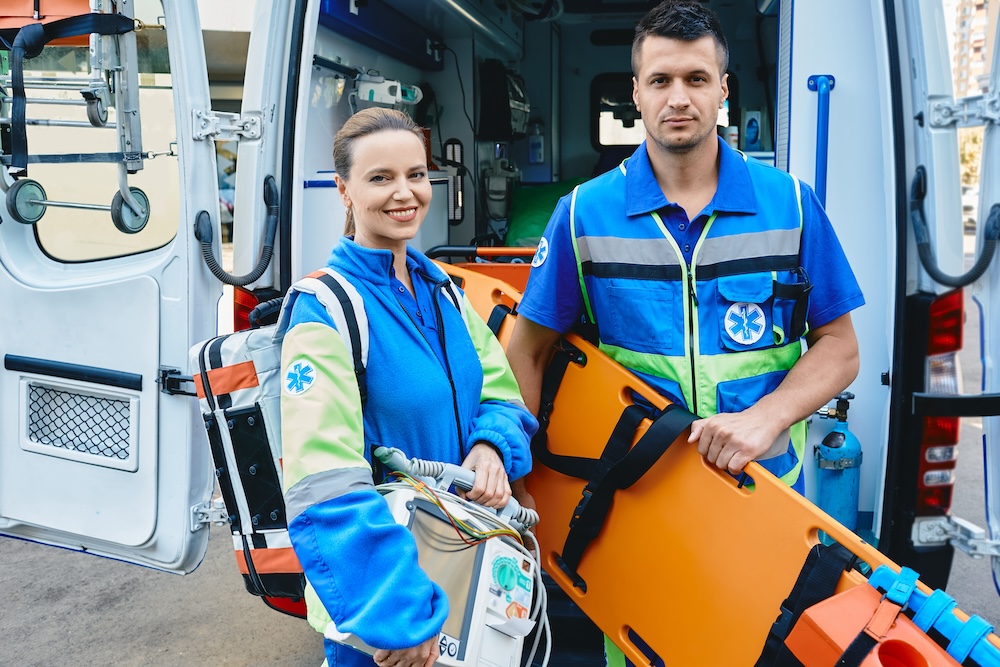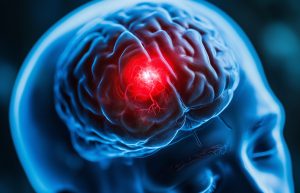For patients with traumatic brain injuries (TBIs), delays in diagnosis can mean the difference between recovery and long-term damage. Traditionally, diagnosing internal brain bleeds like subdural and epidural hematomas required hospital-based imaging, such as CT scans.
However, advancements in technology are now enabling paramedics to detect these critical conditions right at the scene. This blog explores the transformative potential of portable brain imaging devices, particularly ArcheOptix’s NIRD® technology, in prehospital settings.
Current Limitations in the Field
Paramedics are often the first point of contact for trauma patients, whether it’s at the scene of a car crash, a sports injury, a fall at home, or a battlefield incident. In these high-pressure, time-sensitive environments, EMS teams must make critical decisions quickly, with limited tools and incomplete information. Their assessments are primarily based on a triad of techniques that have long served as the foundation of field trauma evaluation:
- Visual Examination: This includes checking for visible signs of trauma including lacerations, contusions, skull deformities, or bleeding. However, brain injuries often occur without any external indications. A patient may have suffered a significant intracranial bleed even if there are no obvious head wounds or deformities. Visual cues alone simply can’t detect what’s happening beneath the skull.
- Vital Signs Monitoring: Paramedics assess heart rate, respiratory rate, blood pressure, and oxygen saturation to determine systemic responses to trauma. These indicators can be lifesaving in many contexts, but in cases of brain bleeds, vital signs may remain deceptively normal, at least in the early stages. Intracranial pressure might be rising silently while vitals still fall within acceptable ranges.
- Response to Pain and Consciousness Checks: Tools like the Glasgow Coma Scale (GCS) are used to evaluate a patient’s level of consciousness by observing eye, verbal, and motor responses. While GCS is standard in head injury assessment, it has its drawbacks. Some patients with life-threatening hematomas may still score well initially. A lucid interval, when a patient appears alert after head trauma before suddenly deteriorating, is a well-documented phenomenon, especially in epidural hematomas.
While these methods are invaluable in the absence of imaging, they offer only an indirect and often delayed picture of what’s happening inside the brain. And the consequences of relying on them alone can be life-altering.
The Hidden Threats of “Normal”
One of the most dangerous aspects of brain bleeds is their ability to mimic stability. A patient who is coherent, alert, and walking can still be experiencing a slow but deadly internal bleed. This deceptive presentation increases the risk of under-triage, where a patient isn’t taken to a trauma center or doesn’t receive imaging promptly, because they don’t appear to need it.
Unfortunately, the field environment isn’t forgiving when it comes to subtle symptoms. Noise, chaos, poor lighting, and limited time all work against EMS teams trying to make nuanced clinical decisions. And while erring on the side of caution sounds ideal, over-triage—sending every head trauma to a trauma center—isn’t feasible, especially in regions with strained emergency departments or long-distance transport times.
The Challenge of Rapid Decision-Making
Another issue is the lack of immediate diagnostic support. Even in regions where protocols allow paramedics to contact trauma centers directly, the decision to bypass local hospitals or call in neurosurgical backup usually requires imaging confirmation, which isn’t available in the back of an ambulance. This leaves EMS providers in a difficult position: Do they risk overwhelming a trauma center with a patient who might not need it, or under-triage a patient who does?
The current tools at a paramedic’s disposal simply weren’t built to answer that question with confidence. That’s where emerging technologies like ArcheOptix’s NIRD® device can make a powerful difference.

The Reality of Under-Triage
Under-triage occurs when a patient’s injuries are more severe than initially assessed, leading to delays in receiving appropriate care. Studies indicate that injury severity is underestimated in up to 30% of patients (Canadian Journal of Surgery), contributing significantly to preventable trauma morbidity and mortality.
This underestimation can result in:
- Delayed Neurosurgical Intervention: Critical time lost before surgical decompression.
- Inappropriate Transport Decisions: Patients taken to facilities lacking neurosurgical capabilities.
- Increased Mortality and Morbidity: Due to delayed diagnosis and treatment.
The Impact of Prehospital Diagnostic Tools
Recent research underscores the growing value of prehospital diagnostic tools in trauma care, particularly in identifying time-sensitive, life-threatening conditions like traumatic brain injuries (TBIs) and internal hemorrhages before patients reach a hospital setting.
- A study published in BMC Emergency Medicine evaluated multiple prehospital trauma triage tools to determine how well they predicted the need for resuscitative interventions within 24 hours, such as surgery, blood transfusion, or ICU care. The findings revealed a concerning gap in the ability of standard assessment protocols to consistently identify high-risk patients. This reinforces the need for more objective, real-time diagnostic supportthat can detect invisible injuries and support clinical decision-making in the field.
- In another review published by BMJ Open, researchers examined the importance of early detection of intracerebral hemorrhage (ICH), a type of brain bleed that can rapidly worsen if not treated early. The study highlighted that hematoma expansion often occurs within the first 2–3 hours, a window that typically begins before the patient even arrives at the hospital. Delays in diagnosis during this crucial time can lead to irreversible brain damage or death.
These findings suggest that if EMS teams are equipped with reliable, field-ready diagnostic tools, such as ArcheOptix’s NIRD® device, they could intervene faster, triage more effectively, and make transport decisions that align with the patient’s true condition, rather than what is visible externally. This could ultimately lead to better outcomes, fewer missed injuries, and more efficient use of trauma care resources.
Early Bleed Identification: A Game Changer
Identifying brain bleeds at the scene offers significant advantages:
- Faster Neurological Consults: Immediate detection allows for prompt communication with neurospecialists.
- Targeted Transport: Patients can be directed to facilities equipped for neurosurgical intervention.
- Timely Treatment: Early administration of therapies to mitigate hematoma expansion.
Such proactive measures can reduce the time to definitive care, improving survival rates and neurological outcomes.
Introducing NIRD® Technology
ArcheOptix’s NIRD® (Near-Infrared Diffuse Reflectance) technology represents a groundbreaking shift in how paramedics and first responders approach head trauma. Traditionally, identifying a brain bleed required transporting the patient to a hospital with access to CT imaging, but the NIRD® brings that capability directly into the field. It’s a compact, non-invasive device that delivers hospital-grade diagnostic insight when and where it matters most.
How It Works
- Scan the Patient: The process begins with placing the NIRD® device gently on the patient’s head. Unlike other imaging systems, there’s no need to shave the area, apply conductive gels, or adjust for alignment. The device is designed for fast deployment in high-pressure settings. whether in the back of an ambulance, on the sidelines of a sports field, or at the scene of an accident.
- Analyze the Light: Once positioned, the device emits near-infrared light, which safely penetrates the scalp and skull. This light interacts with brain tissue and blood, and the reflected signal is measured and analyzed in real time. The underlying technology is sensitive to the optical differences between healthy tissue and areas where blood has pooled, such as in a hematoma.
- See the Results: Within just a few minutes, the system displays a clear result indicating whether an acute subdural or epidural hematoma is present. This empowers EMS professionals to make faster, more informed decisions about care and transport, potentially long before a CT scan would have been accessible.
Key Features
- CT-Level Sensitivity & Specificity: With accuracy rates between 95–98% for acute subdural and epidural hematomas, the NIRD® delivers diagnostic confidence equivalent to hospital-based imaging. This level of performance helps eliminate guesswork and ensures patients receive timely treatment when every minute counts.
- Portable & Lightweight: Weighing only 8.5 lbs, the device is engineered for use in the field. It’s easy to transport, easy to store in emergency vehicles, and simple to operate under stress, making it a practical addition to paramedic and first responder kits.
- Health Canada Approved: Regulatory clearance means the NIRD® meets rigorous standards for safety, accuracy, and clinical reliability. It’s trusted for use across a wide range of healthcare environments, from ambulances and clinics to rural health centers and military operations.
- Cost-Effective: Compared to the high cost and logistical complexity of CT imaging, the NIRD® offers a streamlined alternative. It reduces unnecessary hospital transfers, limits exposure to radiation, and helps prioritize scarce resources, all while delivering faster results at a lower cost.
Transforming Prehospital Care
The integration of NIRD® into EMS protocols doesn’t just add convenience, it has the potential to reshape the entire approach to field triage. By delivering real-time brain injury diagnostics at the scene, it enhances nearly every aspect of trauma response.
- On-the-Spot Diagnosis: EMS providers no longer need to rely solely on indirect assessments. With the NIRD®, they can immediately determine whether a brain bleed is present, which directly informs treatment urgency and next steps.
- Smarter Transport Decisions: Instead of defaulting to the nearest facility or over-triaging to a trauma center “just in case,” paramedics can make data-backed decisions. If a hematoma is detected, the patient can be fast-tracked to a neurosurgical center. If not, unnecessary transfers may be avoided altogether.
- Combat ER Overcrowding: Emergency departments are often overwhelmed, and not every head injury requires a CT scan or hospital admission. The NIRD® helps ensure that only patients who need advanced imaging or neurosurgical care are sent to the ER, preserving hospital capacity for critical cases.
- Safe and Non-Invasive: Unlike X-rays or CT scans, the NIRD® uses radiation-free optical imaging, making it safe for repeated use, even in children or patients with chronic conditions. It’s particularly valuable in resource-limited environments where imaging equipment is scarce, yet the need for triage is urgent.
Bringing Critical Care to the Point of Injury
The ability to detect brain bleeds in the field marks a significant leap forward in emergency medicine. Giving your team access to tools like the NIRD® means you can catch critical injuries sooner, act faster, and deliver the care your patients need when it matters most. As technology continues to evolve, embracing innovations like NIRD® will be crucial in advancing prehospital care and improving patient outcomes.
About ArcheOptix
ArcheOptix is a Canadian medical device company dedicated to transforming the way Traumatic Brain Injuries are assessed, delivering CT-level accuracy for rural communities, emergency response teams, sports medicine, and more. Our focus on innovation and clinical excellence drives everything we do.


